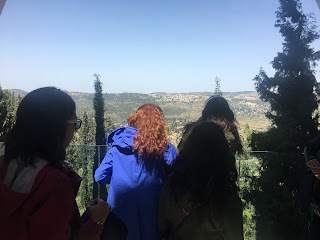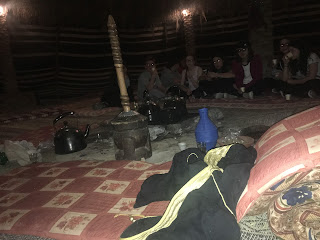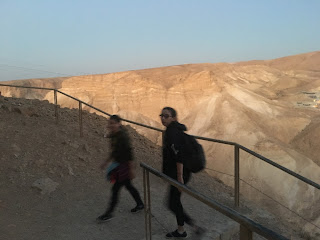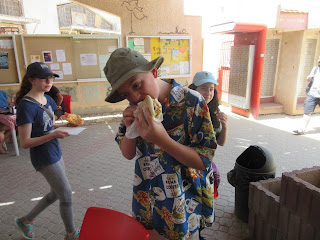Michal pulled us over to the side, allowed other groups to
pass, and said “ok guys” as we crowded around eagerly anticipating what she
might have to tell us about the current pile of rocks before which we stood.
Many times thus far we have gathered around piles of rocks which have come
alive with tales of biblical heroes and cruel destruction. So we gathered
around the quarry at Masada and talked about how Jewish slaves used to dig for
piles of rocks, and now there’s no Roman Empire, and we just stand around and
look at their rocks.
Traveling with a group this small has been a blessing. We
are very lucky to be traveling with an energetic crew from Calgary, an
experienced and talented tour guide, and a minibus! If we were 14 people on a
50 seat bus, we certainly would have taken longer to build this family
atmosphere we’ve come to treasure.
Daniella’s post was our last chametz-free post. We have
since eaten more than enough pita to make up for lost time. We started on Ben
Yehuda street where chametz consumption resumed through shwarma, hamburgers,
and pizza. There was shopping and ice cream and a good shluff before a really
tough Tuesday.
We spent the day at Yad Vashem and Har Herzel. If you look at the pictures, you can see that at the entrance to Yad L'Yeled is a silver sculpture of a hand holding up 6 torches. There's just unlimited things to look at and learn at Yad Vashem and for some reason the sculpture never caught my eye before. Or else it's new.
The entire campus is full of symbols of coming out of the ashes but the sculpture struck a chord for me. The people who have given their lives or have had them taken from them pass the torch to us. By learning and visiting we accept it, and it is up to us to keep the flames lit when we leave this place.
This reminder came back at us repeatedly as we heard the stories of Michael Levin and Yoni Netanyahu, Channah Senesh, and the Jews at Masada.
Being at the bridge of the museum, watching the sun rise over Masada, and standing at Herzl's grave, you can't help but be inspired by the courage and sacrifice it has taken to get us here and how much life has come from these depths. Hopefully this will hit home when we meet up with the Israelis next week.
Now, interspersed there with all that heaviness was an awesome camel ride, Bedouin feasts, mud-slathering, and floating. On Wednesday, we watched the sun rise in the Judean Desert while everyone at home got ready to go back to school. While they were eating lunch we watched it set in the Negev. But then our guys got to work. They were cutting and gluing, coloring, drawing, and the photographs today got real interesting.
The entire campus is full of symbols of coming out of the ashes but the sculpture struck a chord for me. The people who have given their lives or have had them taken from them pass the torch to us. By learning and visiting we accept it, and it is up to us to keep the flames lit when we leave this place.
This reminder came back at us repeatedly as we heard the stories of Michael Levin and Yoni Netanyahu, Channah Senesh, and the Jews at Masada.
Being at the bridge of the museum, watching the sun rise over Masada, and standing at Herzl's grave, you can't help but be inspired by the courage and sacrifice it has taken to get us here and how much life has come from these depths. Hopefully this will hit home when we meet up with the Israelis next week.
Now, interspersed there with all that heaviness was an awesome camel ride, Bedouin feasts, mud-slathering, and floating. On Wednesday, we watched the sun rise in the Judean Desert while everyone at home got ready to go back to school. While they were eating lunch we watched it set in the Negev. But then our guys got to work. They were cutting and gluing, coloring, drawing, and the photographs today got real interesting.
The day started at Maktesh Ramon snapping a few genius
panoramas before hiking Ein Avdat and visiting Ben Gurion’s grave.
Ben Gurion was a guy who liked a good pile of rocks. He came
from the pogroms and looked at the pile of rocks that is the Negev Desert and
said “here will do, we accept the Partition Plan.” He looked at the pile of
rocks that was Sde Boker and said “here will do, I’d like to take a break from
being prime minister and live here for a while.” He looked at the pile of rocks
on the cliffs and said “here will do,” and he’s still there.
The last stop for the day was in the village of Lakia. We
were going to visit the Huria Bedouin Villa and it definitely didn’t stand out.
When we parked in front of a pile of garbage and broken down cars I thought
this was quite the downgrade from the previous piles of rocks… And then we met
Amal.
Amal took us from the pile into the 200 year old villa mostly to help
drive home her story. Amal was born into a prestigious family who owned the Huria
Villa. While Bedouin women were not forbidden to study in university when she
was 20, they were exclusively allowed to be teachers. When Amal announced she
would be a nurse, her family endured threats, violence, and ostracism in support
of her dream. When trauma forced her from her career as a pediatric oncology
nurse she started an organization to support Bedouin women seeking
opportunities and proper health education. Daniella played a little dress-up,
and we took off for the big city.
Tomorrow we will tour in Tel Aviv. This name is derived from Herzl's dream of turning the ancient land into a modern country. His "Old-New Country" was called in German "Altneuland" and in Hebrew "Tel Aviv."
Aviv is the Hebrew word for the season of Spring. The name Tel Aviv, miles of sand dunes a mere century ago, denotes rebirth, like Altneuland. Like the sunrise at Masada. Like the Jerusalem panorama observed from Yad Vashem and from Herzl's tomb.
"Tel" is defined as a mound that has been created by the repeated destruction and rebuilding of settlements on a specific plot of land. Or: a pile of rocks.







































































































































No comments:
Post a Comment